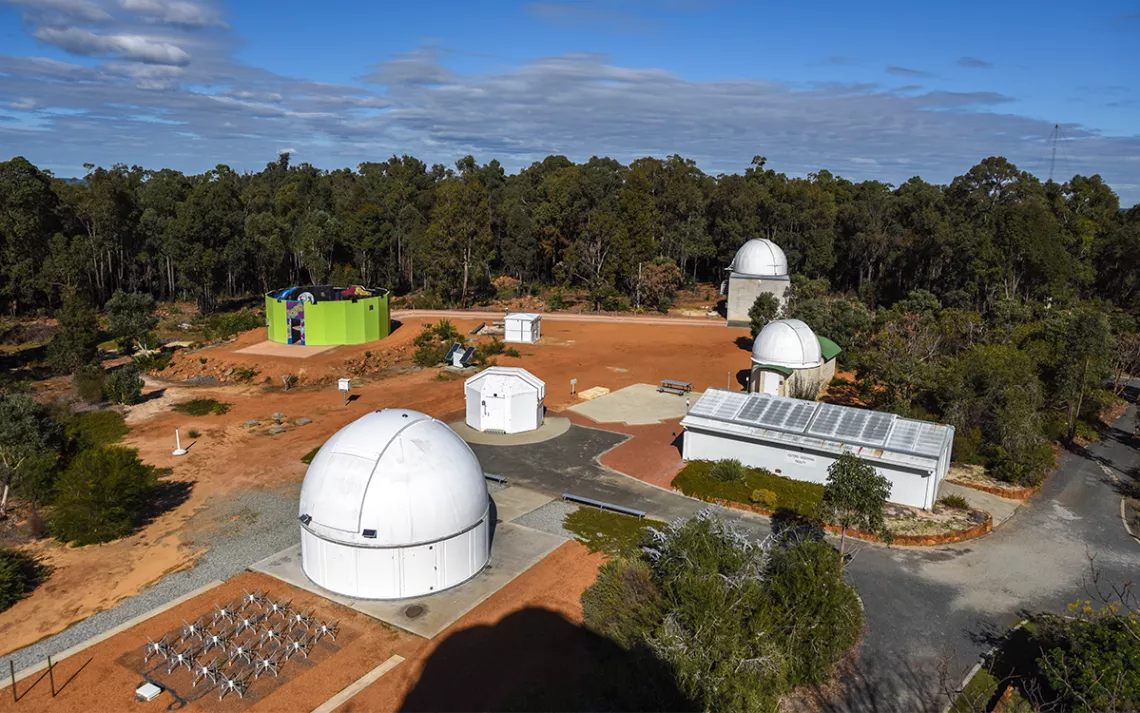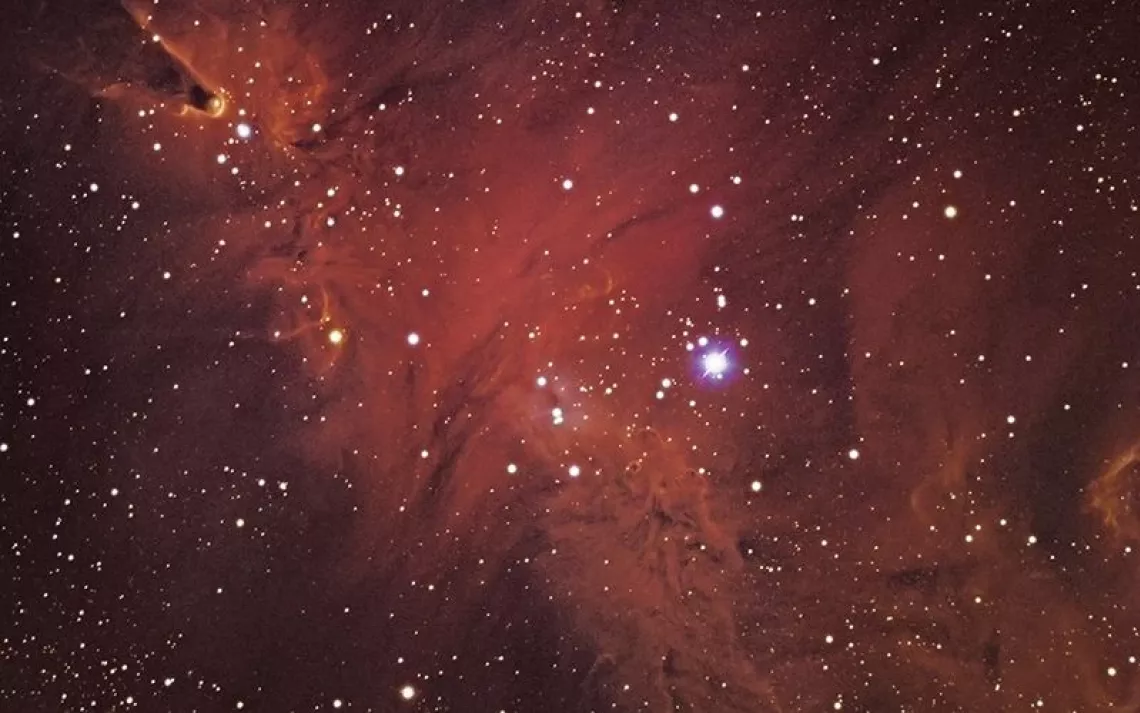Aboriginal Astronomy Finally Gets Its Due
Australia’s Indigenous astronomy shines in new books, festivals, and facilities

Photo by Ronan O'Connell
When Australian Aboriginal astronomer Ghillar Michael Anderson was a young boy, elders of his community chose him as a future leader. As other children played, he kept company with the old men and women, who offered subtle lessons on Indigenous science, society, and culture.
“It would just come up in passing,” said Anderson, now 71 and an elder of the Euahlayi Nation in New South Wales. “They gave me many hints along the way about social interactions and explained stories to give hints about our relationships to birds. They taught me about the behaviors of animals and insects, and how humans interact with the environment. I was taught to really closely observe the world around you and acknowledge it. All this stays with you for the rest of your life.”
With their 60,000-year history, Indigenous Australians are among the world’s oldest cultures. And they’re avid astronomers. Studying the cosmos has informed their traditional navigation, calendars, and weather predictions—but this knowledge was long underappreciated outside Indigenous communities. Today that’s changing, as Australia celebrates Aboriginal stargazing festivals and new Indigenous astronomy facilities. And in 2021, the International Astronomical Union added four Aboriginal star names to its official catalog.
Aboriginal lore reveals careful observation of the world’s patterns. Thousands of years ago, Aboriginal Australians studied the sky to decode natural phenomena, explained Australian astrophysicist Ray Norris, a professor at Western Sydney University and coauthor of the 2009 book Emu Dreaming: An Introduction to Australian Aboriginal Astronomy. For example, the Yolgnu people of Arnhem Land in the Northern Territory attributed the ocean tides to the moon, rising through the ocean, filling with water, then emptying.
“Their model had predictive power: They could predict how high the tide would be based on the phases of the moon,” said Norris. “This contrasted with Galileo’s totally wrong explanation of tides being caused by the earth’s motion, which denied any link between the moon and tides and had no predictive power.”
In his new book, The First Astronomers: How Indigenous Elders Read the Stars, American astrophysicist Duane Hamacher draws on extensive interviews with six Aboriginal and Torres Strait Islander elders, including Ghillar Michael Anderson, to chronicle that heritage. Among a trove of details, this book reveals how Indigenous Australians long ago monitored the scintillation, or twinkling of stars, to predict rainfall, gusts, and fluctuations in temperature.
Anderson said few people outside of Australia’s Indigenous communities were aware of their scientific practices.
“People are beginning to realize the intricate relationship Indigenous people have with the skies, and the sort of unique knowledge we have,” Anderson said. “That’s very healthy for us and for the western world too. It’s exciting to educate the greater world about our astronomy, and our relationship to the skies. We have great stories that tell us so much about the environment and human nature, and they all live in the skies.”
In the Torres Strait Islands, scattered between New Guinea and mainland Australia, new research will contribute to an encyclopedia of local Indigenous star knowledge with an expected release in 2024, said Martin Nakata, a Torres Strait Islander and the deputy vice-chancellor of Indigenous education and strategy at James Cook University. Nakata, who is collaborating with Hamacher on the encyclopedia, hopes it will help encourage Australia’s young Indigenous people to pursue careers in astronomy.
“The stars, just as the land and the seas, are part of our DNA,” Nakata said. “It makes up who we are as Indigenous people. They constitute not just who we are, but also our roles and responsibilities for their good health. As Indigenous people, we understand deeply how we are a part of a universe that has gifted us a planet that can sustain life. That’s why we call this planet our mother. There is no life without her, and she must be protected at all costs.”
Some Indigenous elders can identify dozens of stars by eye and explain the lore associated with each one. One of Anderson’s key areas of knowledge is the celestial emu known as the Gawarrgay. It’s a constellation formed by the dark spaces in the Milky Way, between the Southern Cross and Sagittarius. Depending on where this bird outline sits, Indigenous astronomers like Anderson can make a range of predictions about the behavior of earthly emus, whose eggs have long been a critical source of nutrition for some Aboriginal communities.
Anderson described the Gawarrgay as a “spirit emu” protecting the Euahlayi Nation and its lands. “Because my people are matriarchal, that emu, she monitors the health of the earth all the time,” he said. “She comes down in spirit form and can traverse all the water locations in Australia so they don’t dry out.”
Hiding beyond the Milky Way, meanwhile, are heaven-like places called “camps,” home to the spirits who created the world, Anderson said. Looking at recent images from NASA’s James Webb Space Telescope, he recalled, felt like catching his first glimpse of those camps.
“When these new telescope photos showed all these new galaxies I hadn’t seen before, it made my mouth fall open, because that’s the camps we’ve always talked about,” he said. “That’s where our ancestors are; it’s where we go when we die. We also believe our creators went back up there to be with their ancestors.” Such Indigenous lore featured prominently in this month’s annual Astro Rocks Fest in Mount Magnet, Western Australia. Aboriginal elders held talks on astronomy, Indigenous art exhibitions revealed tales from the sky, and young locals screened short films inspired by Indigenous astronomy.
Western Australia also recently opened an Indigenous astronomy facility at Perth Observatory, a small, open-air structure adorned with a mural of an emu flying toward the moon. At the site, called Worl Wangkiny, Aboriginal guides point out Larawag, Wurren, Ginan, and Unurgunite, four stars the International Astronomical Union has re-cataloged by those traditional names.
Last year, to recognize Anderson’s contributions to the field, the International Astronomical Union also named an asteroid in his honor: 10040 Ghillar. Anderson said he was responsible for passing his knowledge on to younger generations by talking to them about Indigenous astronomy. This role was crucial, as the subject is absent from official Australian curricula.
“Those of us who do know about the sky, and do know its stories, we need to teach that so it doesn’t get lost,” he said. “This is thousands of years of our knowledge. We need to protect it.”
 The Magazine of The Sierra Club
The Magazine of The Sierra Club



